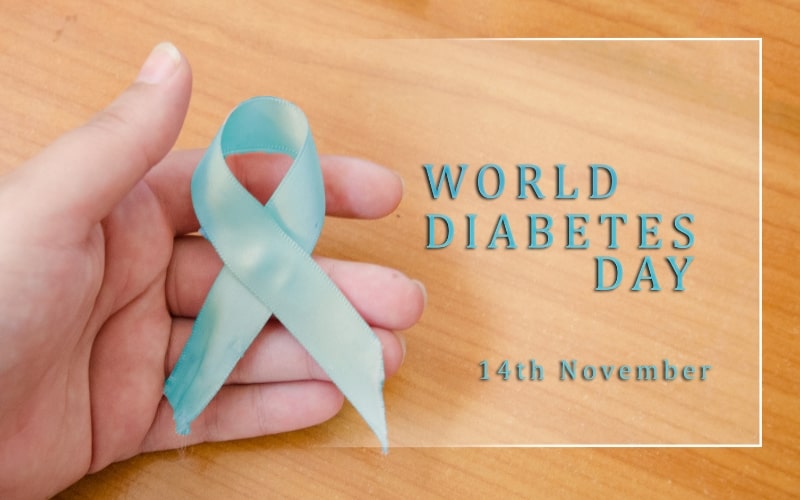World Diabetes Day 2022
- Posted on November 14, 2022
- News
- By Akta Yadav
- 353 Views

World Diabetes Day (WDD) is an important healthcare event held on November 14th each year to highlight the rising prevalence of diabetes and its impact, as well as to educate people about diabetes prevention.
With its presence in more than 160 countries, World Diabetes Day is one of the biggest diabetes awareness campaigns ever organized.
Through its awareness campaigns, advocacy for better access to treatment, and high-quality educational materials to combat diabetes, it has impacted the lives of more than 100 crore people.
Diabetes is a condition where the body has trouble metabolizing and using the glucose that is produced by the food we eat.
The primary energy source in the body is glucose. Ineffective glucose absorption can interfere with daily activities, and uncontrolled diabetes can cause fatal complications like heart problems, nerve damage, kidney damage, foot damage, skin infections, erectile dysfunction, depression, and dental issues.
World Diabetes Day 2022
What is the importance of World Diabetes Day?

The International Diabetes Foundation (IDF) estimates that diabetes claimed 67 lakh lives in 2021 and that 53.7 billion people (or 1 in 10) worldwide were living with the disease at the time.
There is evidence to suggest that this number will rise to 64.3 billion in 2030 and 78.3 billion by 2045.
According to estimates, one in two adults, or roughly 24 crore people, have undiagnosed diabetes, the majority of which is type 2 and which can be avoided by adopting a few healthy lifestyles and eating habits.
Nearly 54.1 crore adults are thought to be at risk of type 2 diabetes because there is a lack of adequate information and guidance to help people understand the signs and symptoms and receive an early diagnosis to begin preventive measures.
Around 10.2 lakh teenagers (0–19 years) are thought to have Type 2 diabetes as a result of the sedentary lifestyle they now lead. Additionally, 1 in 6 live births (2.1 crores) is affected by hyperglycemia during pregnancy.
World Diabetes Day serves as a global platform for the advocacy and prevention of this silent-killer disease. In 2021, 9% of the world's total health expenditures were attributed to the management of diabetes.
To combat this widespread disease and reduce the rising risk of developing diabetes, particularly type 2 diabetes among adolescents and adults, World Diabetes Day was established.
The History of World Diabetes Day
World Diabetes Day (WDD) was established in 1991 by the International Diabetes Foundation (IDF) and the World Health Organization (WHO), and it was designated as a United Nations holiday in 2006 by UN Resolution 61/225.
Sir Frederick Banting and Charles Best co-discovered insulin in 1922, and it was on this day, November 14, that they were honored for their achievements.
The World Diabetes Day campaigns are identified by the "Blue Circle Logo," which was created in 2007, shortly after the day was formally recognized by the United Nations.
Since that time, the Blue Circle has come to represent the world's coalition of diabetes communities fighting the disease's rising incidence.
What are the preventive measures to control Diabetes?
According to the International Diabetes Foundation, there are an estimated 54.1 crore adults who are at risk of developing type 2 diabetes.
Reducing this risk requires promoting awareness campaigns and high-quality platforms for diabetes education that will teach people how to manage and prevent diabetes in its early stages.
With the right lifestyle choices and diet management (low or below 50 on the Glycemic Index diets), type 2 diabetes can be prevented and managed.
Type 2 diabetes, also known as insulin resistance, is a condition in which the body does not produce enough insulin or use it effectively.
This condition can be reversed by leading a disciplined lifestyle, self-monitoring and observing blood sugar fluctuations, and routine doctor visits.
Some diabetes prevention advice is as follows:
- Avoid consuming sugar and refined carbohydrates.
- Practice only taking a small amount of food at a time.
- Include fibers and low-GI foods in your diet.
- Give up smoking because it causes insulin resistance.
- Establish a daily routine of exercising for at least 30 minutes.
- Pay attention to your blood cholesterol level (Ideal should be below 200). Low-density lipoprotein (LDL) levels under 100, high-density lipoprotein (HDL) levels under 20, and triglycerides under 150.
- Maintain proper control over your blood pressure, which should not exceed 130/80.
- Make it a habit to drink regular water instead of aerated beverages or other beverages with added sugar, which can increase the risk of Type 2 diabetes.
What is different in World Diabetes Day 2022?
Under the combined theme of the World Diabetes Day 2021-23 campaign "ACCESS TO DIABETES CARE," the theme for World Diabetes Day in 2022 is "Education to protect tomorrow."
The focus of the year 2022's theme is on comprehensive diabetes education for medical professionals and diabetes patients, which will make it easier for them to access high-quality educational platforms and encourage early diagnosis as well as better lifestyle and preventive recommendations to combat the disease's rising prevalence globally.
This year's theme also emphasizes giving healthcare professionals better educational materials and coaching on how to accurately detect and diagnose diabetes while also making the most of their limited time by educating diabetes patients on how to prevent the disease by making lifestyle changes.
This would undoubtedly offer the patient mental support and aid in helping the patient comprehend his or her current situation to help avoid any further complications.
The theme also aims to inform the public and implores them to urge their public healthcare institutions and other international institutions to facilitate better opportunities, infrastructures, manpower, and financial support to enhance diabetes education to achieve the combined effort of WHO and other organizations to accomplish the diabetes coverage target by 2030.




